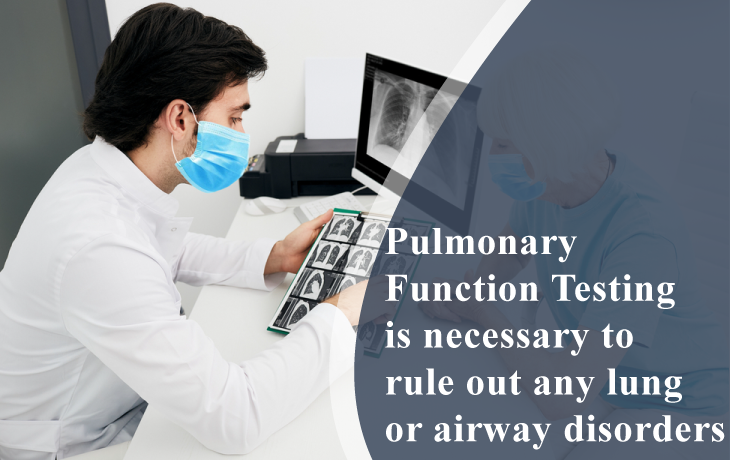So you’ve been feeling under the weather of late and have some issues with your lungs. Thus, you make a doctor’s appointment to rule out anything serious. You’ve also been advised to have a pulmonary function test.
Ever since this recommendation, you have been thinking about this test: what is it and what should you expect? Well, you need not worry, as this article has you covered.
A pulmonary function test, or PFT, helps your doctor measure the function of your lungs. The evaluation can assess how much air you can breathe in and out, how well your lungs move air in and out, and the amount of oxygen in your blood.
Why Is a Pulmonary Function Test Performed?
PFT tests can identify problems with your lungs and help predict your risk of lung disease. This examination can help your doctor determine if you have any lung conditions. Additionally, the pulmonary function test is a safe and painless procedure.
What Are the Different Types of Pulmonary Tests?
The most common type of pulmonary test is spirometry. This test can help diagnose conditions such as asthma, bronchitis, and emphysema.
-
Spirometry helps measure the rate of air flowing in and out of your lungs. The evaluation also gives a rough estimate of the size of your lungs.
To accomplish this test, the technician will ask you to place a mouthpiece in your mouth and a clip on your nose. After doing this, you will be asked to breathe into a tube connected to a special device known as a spirometer. While you will be asked to breathe normally, you also need to breathe as deeply as you can.
-
The second in the list is the lung diffusion capacity, which measures how well oxygen gets into your blood. You will need to breathe in and out through a tube by following certain instructions.
Along with the examination, you may also have a blood test to determine your haemoglobin levels.
-
Lung volume testing is another kind of PFT that is quite similar to spirometry! However, there’s still a difference.
Unlike spirometry, this is done in a small, air-tight booth with clear walls. It is considered one of the best ways to figure out how much air your lungs can hold.
How Long Does the Test Take?
A pulmonary function test (PFT) typically takes only 15 to 20 minutes. But the time may vary slightly depending on your breathing rate and the number of tests requested. Usually, the more tests you have to take, the longer it will take for you to finish all of them.
The examination will begin by having you sit in a chair and breathe normally into a tube connected to a device called a spirometer. This device measures how much air is going in and out of your lungs when you breathe. You’ll be asked to do different things, like blow into the tube or wait while it measures your breathing rate.
The technician will then ask you to breathe faster than normal for several seconds so that they can measure how well your lungs are working when taking deeper breaths.
Finally, they will ask you to do some forced breathing. Afterwards, the technician will review your results with you and answer any questions that you may have.
What Should I Do Before Taking a Pulmonary Function Test?
If you’re preparing to take a pulmonary function test, there are a few things that you should do beforehand.
-
Make sure to let your doctor know if you have any medical or physical conditions that could affect the results, such as asthma, chronic bronchitis, or emphysema.
-
Avoid wearing tight clothing, as this can interfere with the accuracy of the lung volume measurements. You may also be asked to not eat before the test, so it’s best to discuss any diet restrictions with your doctor in advance.
-
If you smoke, stop for at least six hours before the test. It is said that smoking can interfere with the overall results of the test.
-
In addition, try to avoid caffeine and alcohol for 24 hours before the test. These substances also obstruct accurate readings.
-
Refrain from working out strenuously before a PFT. Exercising can cause your lungs to work harder. Consequently, the results of the test are affected.
-
Finally, be sure to bring a complete list of any medications and supplements you are taking, as some may affect your results. That way, the doctor can adjust for any potential interference from those substances.
Doing all these steps before the test will help ensure that you get an accurate reading!
Final Words
So, what are you waiting for? Go and get a pulmonary function test! It could help you breathe a lot easier.
But with so many imaging centres, how do you choose one that is reliable? Well, undeniably, this can be a daunting task.
To make your search easy, Ontario Diagnostic Centres is the brand you can rely on for all your imaging needs. All their centres are accredited, which means they meet high standards of quality and safety – bestonlinecasinocanadarealmoney.com.
What’s more, the label employs the latest equipment for conducting different imaging examinations. Therefore, the authenticity of the reports that you get cannot be questioned.
And they have an experienced staff that creates a comfortable environment when you visit them.

